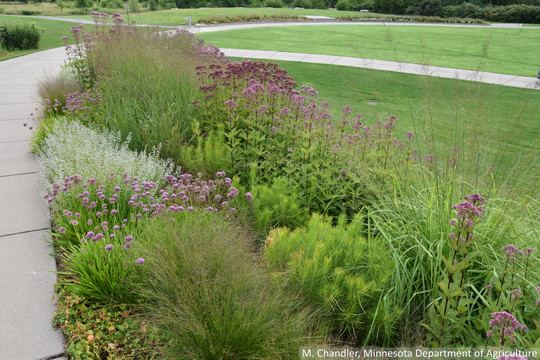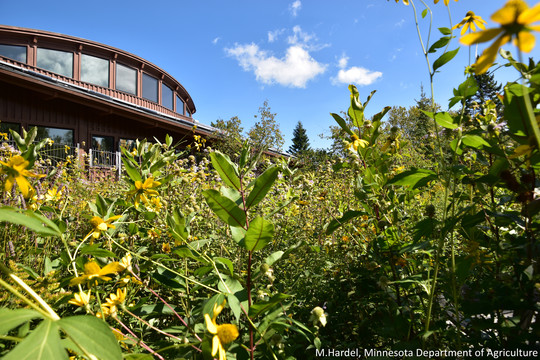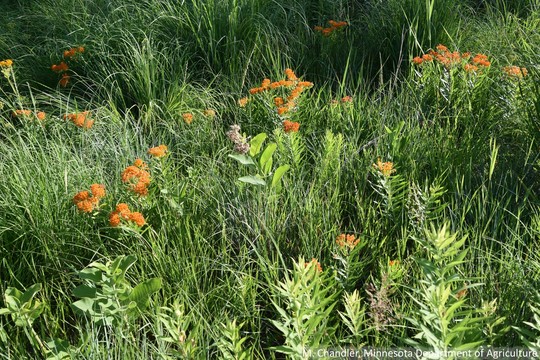|
Having trouble viewing this email? View it as a Web page.
April 30, 2021
May Weed of the Month: Gardening with Non-invasive Plants
Mari Hardel, Minnesota Department of Agriculture
Gardening season is here and after two years in my home I feel motivated to put some time into planting beyond the vegetable garden. But I’m pretty intimidated by all the options: What should I plant? Where should I plant it? Where can I buy it? Will it survive the winter? Will the deer eat it? How tall will it grow? However, I have found some good resources for selecting native and non-invasive plants and preparing the landscape for them to thrive. Simply getting started by trying something out will go a long way to making progress.
Why plant native species? Plants native to a region are, by nature, not invasive, and while you may see them spreading within your garden, they won’t become problematic for the surrounding environment. Planting native species will provide greater benefits for wildlife and native pollinators and won’t need as much fertilizer or water as they tend to have robust root systems. Also, it turns out they are pretty competitive and can result in a beautiful landscape that changes throughout the season. A landscape planted with native plants can either be left alone to do its thing for a natural look, or you can spend more time gardening for a curated or manicured look.
 Native plantings can be used in combination with lawns or other more traditional landscaping like this one at Silverwood Park in St. Anthony, Minn.
Click here to download the image.
Planning and site preparation are important for any landscaping or gardening project. This winter the Midwest Invasive Plant Network (MIPN) put out a new homeowner’s guide for landscaping which breaks down the steps and explains why each part is important. After reading through it, I feel more prepared to tackle my projects this summer.
Last summer I had the foresight to put huge thick tarps out over the grass to kill it in the places I’d like to plant something new. I’ll probably dig out grass in a few more spots this summer to make even more space for all the plants I’ve selected to add to my yard. Once I plant seedlings, I’ll add a bit of mulch to help keep the weeds down and hold some extra moisture in. And, fingers crossed, in just a couple of years things will really take off and look amazing.
 Native wildflower garden at Hartley Nature Center in Duluth, Minn.
Click here to download the image.
As I’ve watched my yard over the past two years, I now know where the wet spots are, the sunny spots, and where the snow plow dumps extra salt. I’ve also noticed the abundance of creeping bellflower and realized that my ash trees are soon to be overtaken by emerald ash borer. So, as I plan, I’m picking out perennial species that will do well in my mostly sunny but really rocky yard and thinking about trees and shrubs that can replace the ash. I’ve also gone for a lot of walks near my home in Duluth to see what native plants are growing and thriving nearby and what plants seem to like growing next to each other.
 Butterfly weed is a native wildflower that has long-lasting blooms and provides a great pop of color to a native plant garden like this one in Silverwood Park in St. Anthony, Minn.
Click here to download the image.
When selecting the plant species you’d like to add, consider looking beyond the big box stores and popular home and garden magazines. Many plants available in big box stores may not be native to our state, and even those that are native should be acclimated to the particular growing zone that you will be planting. The University of Minnesota has a short video and overview on how to properly read a plant and seed label to understand where the species originates from and where it can best be planted.
Avoid planting species on Minnesota Department of Natural Resources’ (DNR) invasive terrestrial plants list. Instead, look at natural areas with conditions similar to the area you are landscaping. Look at the native plant species combinations you like and try to copy these combinations at your location. The DNR has a list of native plant suppliers by region, the Xerces Society’s Pollinator Conservation Resources: Great Lakes Region has a wealth of information to help you select plants, and the Minnesota Board of Soil and Water Resources also has a wealth of information. Most suppliers will be able to provide detailed information about areas where each plant will grow best, like sun or shade, wet or dry, and how tall they’ll get. And remember, you can always start with a small area to keep it easy!
MEDIA: For more information on Weed of the Month, contact Allen Sommerfeld, MDA Communications, at allen.sommerfeld@state.mn.us or 651-201-6185
|